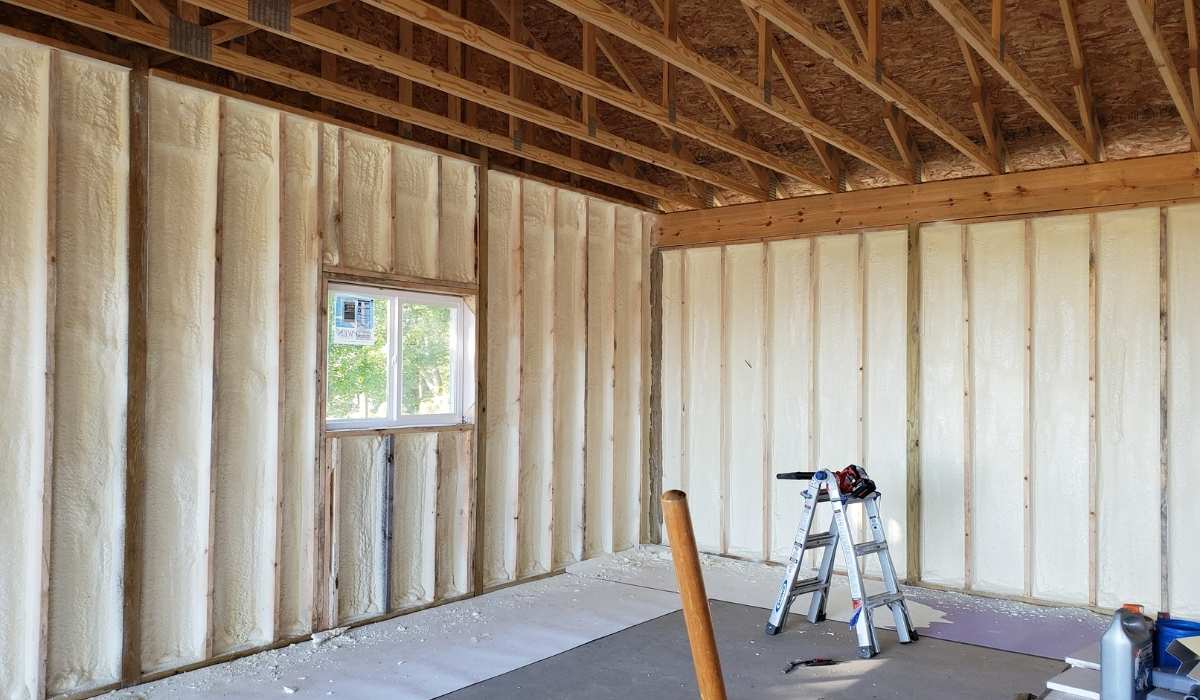Spray Foam Insulation: Is It the Right Choice for Your Home’s Energy Efficiency?
When it comes to creating a home that’s not only comfortable but also energy-efficient, many homeowners are asking, “What more can I do?” One of the most thoughtful answers to that question is spray foam insulation.
Whether you’re building a new home or upgrading an existing one, spray foam has become one of the most effective ways to boost energy savings, improve indoor comfort, and even increase your home’s value. But is it right for you?
Let’s explain everything in a simple, conversational way so you can make the best choice for your home.
Understanding Spray Foam Insulation
Spray foam insulation is a modern, highly efficient way to seal and insulate your home.
It’s made from two main components—polyurethane and isocyanate—which are combined and sprayed into walls, attics, ceilings, and floors.
Once applied, the mixture expands rapidly to fill gaps, cracks, and cavities before hardening into a solid, insulating foam.
There are two main types of spray foam: open-cell and closed-cell. Each has its own benefits and ideal uses.
Open-Cell Spray Foam: Soft, Quiet, and Eco-Friendly
Open-cell spray foam is light, spongy, and full of tiny open cells. These open cells make it softer and more flexible than its closed-cell counterpart.
What makes open-cell foam so popular?
- Soundproofing: Open-cell spray foam is excellent at absorbing sound. So, if you live in a noisy neighborhood or just want a little peace and quiet between rooms, it helps reduce noise transfer.
- Air Sealing expands greatly when applied, sealing even the smallest gaps and helping prevent unwanted drafts.
- Great for Interior Use: It’s often used in walls, ceilings, and attics—places where moisture resistance isn’t the top concern.
- Eco-Conscious Choice: Many formulas use environmentally friendly blowing agents, reducing the overall impact on the planet.
If you’re looking to quiet your home and improve comfort without spending a fortune, open-cell spray foam might be the perfect solution.
Closed-Cell Spray Foam: Strong, Durable, and Moisture-Resistant
Closed-cell spray foam is denser and more rigid, with tightly packed cells that form a solid, waterproof barrier once cured.
Here’s why closed-cell foam shines:
- Higher R-Value: That’s a fancy way of saying it insulates better. If you live in an area with extreme weather, this is a big win.
- Moisture Barrier: Closed-cell foam doesn’t just insulate—it protects. It resists water and humidity, making it ideal for crawl spaces, basements, and exterior walls.
- Adds Structural Strength: Because it hardens into a dense material, it can actually strengthen your walls and roof. That’s especially valuable in areas prone to high winds or storms.
- Perfect for Challenging Spaces: Whether you’re insulating a metal building or waterproofing an exterior wall, closed-cell gets the job done.
So, if your home deals with moisture, needs top-tier insulation, or needs a durability boost, closed-cell spray foam may be worth the investment.
Why Homeowners Love Spray Foam Insulation
Choosing insulation might not sound exciting—but when you hear about the benefits spray foam delivers, it becomes clear why it’s the talk of the town.
Energy Efficiency That Pays for Itself
Spray foam creates an airtight barrier that reduces energy waste. Here’s what that means for you:
- Lower Heating Bills: Keeps warm air in during winter.
- Lower Cooling Bills: Keeps hot air out during summer.
- Less Work for Your HVAC: Your systems last longer and use less energy.
Over time, the savings on your energy bills often pay for the initial installation.
Seals Like a Pro
Traditional insulation materials can leave tiny gaps. Spray foam doesn’t.
It expands and sticks to surfaces, sealing even the most minor cracks and openings.
That means no more drafts sneaking through your attic or basement.
Long-Lasting Durability
Unlike fiberglass or cellulose, which can sag or degrade, spray foam lasts for decades without losing effectiveness.
It won’t settle, rot, or attract pests, and it keeps performing year after year.
Moisture Resistance = Healthier Home
Closed-cell spray foam acts as a moisture barrier, keeping your home dry, especially in humid climates.
That means fewer problems with mold and mildew, which are not only gross but also dangerous to your family’s health.
Peace
Open-cell spray foam helps block sound from traveling between rooms—or from the outside world.
It’s an excellent choice for bedrooms, nurseries, or even home theaters.
The Spray Foam Installation Process

Are you thinking of having spray foam installed? Here’s what the process looks like when you hire a professional crew:
Step 1: Assessment
A contractor will evaluate your home’s needs—attics, walls, and crawl spaces—and help you decide whether open-cell or closed-cell spray foam is a better fit.
Step 2: Prep Work
This means clearing out any old insulation, cleaning the application area, and ensuring it’s dry and ready for foam.
Step 3: Mixing On-Site
Spray foam is created on the spot by mixing two chemicals. This ensures a perfect, active mixture for your home’s surfaces.
Step 4: Application
Using a specialized spray gun, the foam is applied to your walls, roofline, or wherever needed. It quickly expands to fill every crack.
Step 5: Curing
It usually takes just a few hours for spray foam to harden and finish expanding. Once cured, it’s solid, durable, and ready to go.
Step 6: Final Inspection
The installer checks everything to make sure the foam has filled all necessary gaps and formed a uniform, airtight barrier.
Step 7: Clean-Up
A good contractor will leave the job site clean, trimmed, and ready for the next stage of your home improvement.
Maintenance and Upkeep
The best part about spray foam? It’s virtually maintenance-free.
However, it’s still smart to check on it every year:
- Look for signs of wear, such as cracks or moisture.
- Check seals around windows or doors for air leaks.
- If you ever do a significant remodel, have the insulation reinspected.
For most homeowners, though, it’s install it and forget it.
Spray Foam Insulation Cost Considerations
Spray foam isn’t the cheapest insulation on the market, but it offers the best value over time.
Here’s what affects the cost:
- Type of foam: Closed-cells are more expensive than open-cells.
- Size of the area: Bigger homes mean more foam and more labor.
- Where you live: Prices can vary by region.
Despite the upfront investment, most homeowners see a solid return on their money:
- Lower utility bills
- Fewer repairs from moisture damage
- Higher home resale value
Think of it as an investment in both your comfort and your home’s long-term efficiency.
Why Spray Foam Might Be the Right Choice for You
If you’re tired of high energy bills, dealing with noisy rooms, or want a home that feels solid, comfortable, and eco-friendly—spray foam insulation is worth serious consideration.
It insulates better, lasts longer, resists moisture, and adds real value to your home.
Whether you’re building from scratch or upgrading an older house, spray foam makes a noticeable difference.
Why Professional Spray Foam Installation Is So Important
While spray foam insulation offers incredible benefits, those advantages depend heavily on proper installation.
Professional installers have the training, equipment, and experience needed to mix the chemicals correctly, apply the foam evenly, and ensure a safe, airtight seal.
sImproper installation can lead to poor insulation performance, uneven coverage, lingering odors, or even long-term structural issues.
Professionals spray foam installation also understand building codes and safety protocols, ensuring your project meets local regulations and passes inspections.
But hiring an expert guarantees you get the full value of your investment—maximum efficiency, durability, and peace of mind.
Final Thoughts
Spray foam insulation isn’t just another home improvement—it’s a lifestyle upgrade.
It offers peace, protection from the elements, and real savings on your energy bills.
More than anything, it gives you control over your home’s environment—making it more comfortable, healthier, and more efficient for years to come.
Ready to explore how spray foam can work for your home?
Contact us today—your trusted source for reliable, professional spray foam insulation solutions. Start saving energy, improving air quality, and living more comfortably today.
FAQs About Spray Foam Insulation
What’s the difference between open-cell and closed-cell spray foam?
Open-cell foam is softer and better at soundproofing, while closed-cell is denser, waterproof, and provides a higher R-value. The right choice depends on your specific needs and where you’re applying it.
Is spray foam safe for my family and pets?
Yes, once cured, spray foam is safe. Professionals should handle the application process, and you’ll typically need to vacate the area for a few hours during and after installation.
How long does spray foam insulation last?
Spray foam can last over 30 years with little to no degradation, offering long-term energy savings and structural benefits.
Can I install spray foam myself?
It’s highly recommended to hire professionals. The chemicals involved require proper handling, and precise application ensures the best performance and safety.
Will spray foam reduce noise in my home?
Yes, especially open-cell spray foam, which is excellent at absorbing sound and reducing noise between rooms and from outside sources.
How does spray foam help with moisture problems?
Closed-cell spray foam is water-resistant and forms a moisture barrier, which helps prevent mold, mildew, and rot in areas like basements and crawl spaces.
Is spray foam worth the cost?
Absolutely. Though it costs more upfront, the energy savings, durability, and added home value often make it a wise long-term investment.
Where can spray foam be used in a home?
Spray foam works well in attics, walls, crawl spaces, basements, ceilings, and even roofs. It’s versatile enough for both new builds and retrofits.

